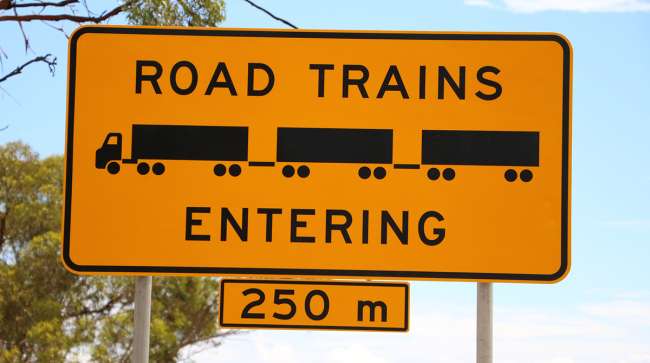Staff Reporter
North Dakota Bill Proposes Amending Truck Restrictions for Road Train Pilot

[Stay on top of transportation news: Get TTNews in your inbox.]
Legislation that would temporarily amend truck length and weight restrictions is making its way through the North Dakota Legislative Assembly.
Specifically, the concurrent resolution requests adjusting restrictions on state highways and interstates that are part of the National Network so as to allow North Dakota to conduct a “road train” pilot program. A road train is composed of two or more linked trailers that are hauled by a single tractor unit.
The National Network mentioned in the legislation refers to a system of state highways and interstates that are used by commercial trucks. In North Dakota, routes that are on the National Network include Interstate 94 and a portion of state Route 13. North Dakota Department of Transportation spokesman David Finley explained the National Network has a cargo carrying length of 100 feet.

Fleets are investing in tech-based safety tools that inform and forewarn potential risk. But how do they condition and prepare drivers to respond to safety alerts? Find out as the RoadSigns Team speaks with Tom DiSalvi, VP of Safety at Schneider National, and Charlie Mohn, Director of Product Innovation at Drivewyze. Hear a snippet, above, and get the full program by going to RoadSigns.TTNews.com.
State Sen. Oley Larsen (R-Minot) said the concurrent resolution has passed the Senate Transportation Committee and will need to be heard on the Senate floor when the lawmakers return from their break, which is known as crossover. The Legislative Assembly is scheduled to reconvene March 3. Larsen, who holds a degree in diesel technology, said legislation requesting adjustments to truck length and weight limits has also been directed to North Dakota lawmakers at the federal level.
“The one need is that the more you can take trucks off the road, the less accidents you’re going to have and the lower carbon footprint you’re going have,” Larsen told Transport Topics. “If you have one tractor-trailer hauling three trailers instead of three tractor-trailers hauling three trailers, you’re taking two drivers off the road and having a smaller carbon footprint. It takes the same amount of fuel to pull those three trailers with one truck.”
Besides offering a safer and more energy-efficient transportation solution, Larsen said road trains can provide relief from issues related to the truck driver shortage and assist with regional commerce. Allowing these configurations would help haulers in North Dakota better coordinate with freight moving through neighbors such as South Dakota and Canada, which allow similar load configurations, Larsen said.
“There needs to be harmonization between the trucking of commerce,” Larsen told TT. “What the bill’s going to really do is harmonize between the states.”
According to the text of the concurrent resolution, meeting demands for freight in a timely manner has grown more difficult because of the truck driver shortage and reduced rail infrastructure. State Sen. Larry Luick (R-Fairmount) noted that a flat and sparsely populated state such as North Dakota would serve as “perfect place to experiment” with road trains.
“The North Dakota Motor Carriers Association supports House Concurrent Resolution 3001, if considerations to safety and infrastructure are considered,” NDMCA Office Manager Kacey Heidrich told TT. “An effective pilot project would collect data on impacts to infrastructure and safety.”
Finley indicated vehicle weight limits in North Dakota vary based on the route. The weight limit on interstates is 80,000 pounds, unless the driver possesses a permit to exceed that limit. On state highways, the weight limit is 105,500 pounds. Finley also said there is an exemption that allows trucks to weigh up to 129,000 pounds, which is only permissible on certain designated routes.
In acknowledgment of concerns over infrastructure, Luick, who also has training as a diesel mechanic, noted the road trains would not exceed axle load limitations.
Pending the legislation’s passage, Larsen said the pilot project would start in August and would run for two years. The concurrent resolution requests to permanently amend length and weight restrictions to allow road trains if the pilot program is successful. Luick expressed optimism about the legislative future of the proposed pilot program.
“I feel that we are looking at a pilot program that’s going to go ahead,” Luick said. “What I’m after is to take away that total vehicle length and total vehicle weight [restrictions] because that’s what’s limiting industry right now. I’m hoping that everybody takes a step back [and] a big breath of air and realizes that this could be a very good energy-efficient proposition.”
Want more news? Listen to today's daily briefing below or go here for more info:




